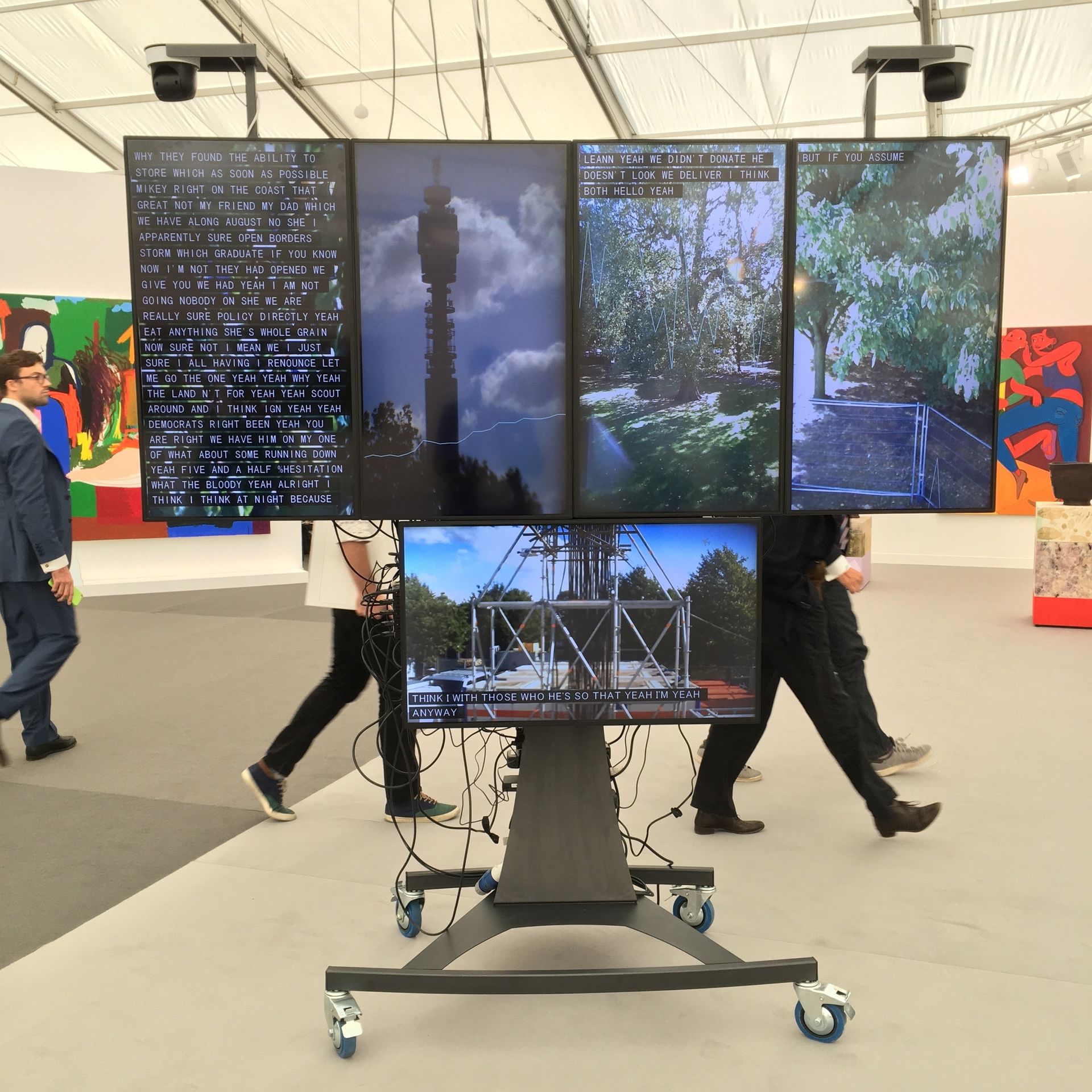At Frieze this year, you will become part of a work of art, whether you like it or not. Similar to the mass surveillance tactics used by governmental agencies, Yuri Pattison’s Frieze Projects commission will keep a watchful eye, and ear, on visitors. “It’s in the terms and conditions,” he says—once you enter the fair “you give permission to be filmed and recorded”. The data, gathered through a number of means, will then be relayed on a series of monitors, which themselves gather further information.
The Dublin-born artist lives in London, where he studied fine art at Goldsmiths. The 2016 Frieze Artist Award winner first grabbed the attention of the art world as part of the London-based collective Lucky PDF. The group produced a particularly memorable Frieze Projects commission in 2011, building a live TV studio complete with performances, interviews and two huge wrestlers causing havoc in the fair.
Pattison, who is no longer an active member of the collective, makes work about the growing pervasiveness of digital technologies. His work often exists both digitally and physically, and attempts to “poke a hole in this glossy aesthetic [exemplified by] every release of the iPhone—when your own phone has a cracked screen or is not working”.
Pattison had his first major show in a public institution at London’s Chisenhale Gallery this summer. He is represented by Mexico City’s Labor gallery and Mother’s Tankstation Limited in Dublin, which is showing his works at the fair.
The Art Newspaper: Tell us how about your Frieze Projects commission, Insights (crisis trolley), and how the work came about.

Yuri Pattison: The commission asked for some sort of response to the fair, and I was thinking about the artificialness of this temporary structure and also about it being this generic international space—because being at Frieze London is very similar to being at Frieze New York. I was also thinking about something [the Frieze Art Fair co-founder] Matthew Slotover said in relationship to the fair’s new partnership with [the Beverly Hills talent agency] William Morris Endeavor-IMG. There was wild speculation about there being another fair in Los Angeles. But he said, very obliquely, that this agency understood that there is a lot of content at the fair, and that a lot of that content is under-exploited. I was kind of thinking about what he meant. As I say, it was very oblique. I was thinking about art being at this tipping point of possibly becoming content or becoming a new industry. So [the work] is touching upon all of those things and the context it is being shown in, while also using the fair to produce content and produce the work.
What kind of content will be produced by the fair?
There will be various types of data from a huge amount of cameras and eavesdropping microphones. We’re playing with the information coming from that. It’s all displayed on a big board system that you would be more familiar with in an airport environment.
Mass surveillance has been a theme in your work before. You made the piece 1014 (2015) about the Hong Kong hotel room where Edward Snowden was holed up following his leaking of classified NSA documents. How did this work come about?
I was interested that no one was talking about which hotel it was. Then, on a hotelier forum, which just seems to be concierges talking among themselves, I found this post. A few days after the article in the Guardian newspaper came out this guy was saying: “Oh I have a hunch which hotel it is, and I can probably figure out what room it is as well. I’ll confirm this.” He phoned up [the hotel] and pretended to be someone from the Guardian, and offered to extend Edward Snowden’s room. Through offering that he could then ask, “Oh, which room is it?” And they gave him the information freely. The weakest link in most hacking is the human element. I found it interesting that someone had, in that moment, kind of hacked Edward Snowden and it was just some concierge.
The work that you developed during your residency at the Chisenhale Gallery looked at the rise of shared working spaces. What drew you to these particular places?
I think [shared working spaces] raise a lot of questions, which are pertinent for most young people within the city. If you’re freelancing, it is an environment that you have to pay to exist in. It is also an imprint of the space issue within London. And it affects artists as well—rather than having a studio model, many [of these] new project spaces will have a co-working or desk-space model because [the companies] can make so much money from them. I was interested in these bigger questions, and negotiating my own experience of never being able to afford a studio. And now my own practice has evolved to not really exist within a studio. I found a more interesting place to make work, which was online, and I could find an audience very quickly through that.
You used to live in Peckham, a neighbourhood that has had a very active young art scene for the past decade but has since become unaffordable for many artists. Are we now looking at a city with fewer artist areas?
A lot of people have pinpointed that something like [the] Peckham [art scene] will get targeted very quickly. Property developers are smart: they know that if there are artists in the area, there is an opportunity to be had. It’s a difficult one—it’s almost impossible to break out of being a cog [in the gentrification process]. Giving the least leeway to branding an area, or a scene, a way around that. If you’re very vocal about how great an area is, and brand yourself around it, then the scene doesn’t exist in two years for those very same reasons.

